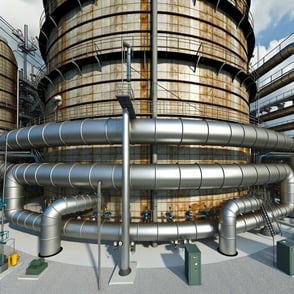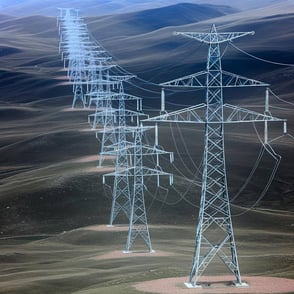Pumped Hydro Storage
Pumped hydro storages store energy by pumping water to an upper reservoir and releasing it to generate electricity, balancing supply and demand, and supporting renewable energy integration.
What is Pumped Hydro Storage?
Pumped hydro storage (PHS) is a form of energy storage that makes use of hydropower. It is the most widely used form of large-scale energy storage in the world. The concept involves moving water between two reservoirs at different elevations to store and generate electricity. When demand for electricity is low, cheap power is used to pump water from the lower reservoir to the upper reservoir. When demand is high, the stored water is released back to the lower reservoir through turbines, generating electricity. This method of mechanical energy storage helps balance supply and demand, supports grid stability, and facilitates the integration of renewable energy sources.
How Pumped Hydro Storage Works
Pumped hydro storage systems consist of two main components: the upper and lower reservoirs, and the equipment used to move water between them, which includes pumps, turbines, and generators.
During periods of low electricity demand or when cheap energy is available from sources like wind or solar power, water is pumped from the lower reservoir to the upper reservoir using electric pumps. This process converts electrical energy into potential energy, storing it for later use. When electricity demand is high or there is a shortage of power supply, the stored water in the upper reservoir is released back to the lower reservoir. As the water flows downhill, it passes through turbines, causing them to spin. The turbines are connected to generators, which convert the mechanical energy of the spinning turbines into electrical energy. This electricity is then fed back into the grid to meet the increased demand.

The efficiency of pumped hydro storage systems is typically between 70% and 80%, meaning that a significant portion of the energy used to pump the water can be recovered during the generation process. The system's ability to quickly switch between charging and discharging modes makes it highly responsive and effective for balancing grid supply and demand.
Pumped hydro storage systems can be classified based on their configuration and location: closed and open-loop systems. Closed-loop systems are not connected to natural bodies of water and use two artificial reservoirs. Closed-loop systems can be built in locations where natural water bodies are not available, offering greater flexibility in site selection. Open-loop systems are connected to natural water bodies, such as rivers or lakes, and use these natural resources as one or both of the reservoirs. Open-loop systems can be more cost-effective but may have greater environmental impacts due to their interaction with existing ecosystems.
The Impact of Pumped Hydro Storage on the Energy Sector
Pumped hydro storage has a significant impact on the energy sector by providing a reliable and efficient means of large-scale energy storage. This technology supports grid stability, enhances the integration of renewable energy sources, and offers economic and environmental benefits.
Pumped hydro storage helps maintain grid stability by providing a rapid response to fluctuations in electricity demand and supply. By storing excess energy during periods of low demand and releasing it during peak demand, PHS systems help balance the grid and prevent blackouts or power shortages. In the same way, pumped hydro storage enables the efficient integration of these variable energy sources by storing excess renewable energy and releasing it when needed. This capability helps smooth out the fluctuations caused by renewable energy generation and ensures a consistent power supply.
Pumped hydro storage is a clean and sustainable energy storage solution with minimal environmental impact compared to other forms of energy storage. By enabling greater use of renewable energy sources and reducing reliance on fossil fuels, PHS systems help decrease greenhouse gas emissions and promote environmental sustainability.
Conclusion
PHS is an essential technology for modern energy systems, offering a robust solution for large-scale energy storage. By effectively managing the balance between electricity supply and demand, PHS systems play a critical role in maintaining grid stability and supporting the integration of renewable energy sources. These systems not only enhance the reliability of the electricity grid but also contribute to economic growth and environmental sustainability. As the energy landscape continues to evolve towards cleaner and more renewable sources, the importance of pumped hydro storage in providing dependable and efficient energy storage will only increase, ensuring a resilient and sustainable future for energy infrastructure.
Glossary
- Pumped Hydro Storage (PHS): A type of hydroelectric power generation that stores and manages energy by moving water between two reservoirs at different elevations.
- Upper Reservoir: The higher-elevation reservoir in a pumped hydro storage system where water is stored during periods of low electricity demand.
- Lower Reservoir: The lower-elevation reservoir in a pumped hydro storage system where water is released to generate electricity during periods of high demand.
- Turbine: A device that converts the kinetic energy of flowing water into mechanical energy, which is then used to generate electricity.
- Generator: A machine that converts mechanical energy from a turbine into electrical energy.
- Closed-Loop System: A pumped hydro storage system that uses artificial reservoirs isolated from natural water bodies.
- Open-Loop System: A pumped hydro storage system that is connected to natural water bodies, such as rivers or lakes.
- Grid Stability: The ability of the electricity grid to maintain a consistent and reliable supply of electricity despite fluctuations in demand and supply.
- Renewable Energy: Energy generated from natural resources that are replenished continuously, such as wind, solar, and hydropower.
- Greenhouse Gas Emissions: Gases released into the atmosphere that contribute to the greenhouse effect and global warming, such as carbon dioxide and methane.
.png?width=200&height=80&name=etpa-logo-color%20(1).png)































.png)
.png)
-1.png?width=250&height=100&name=etpa-logo-color%20(1)-1.png)